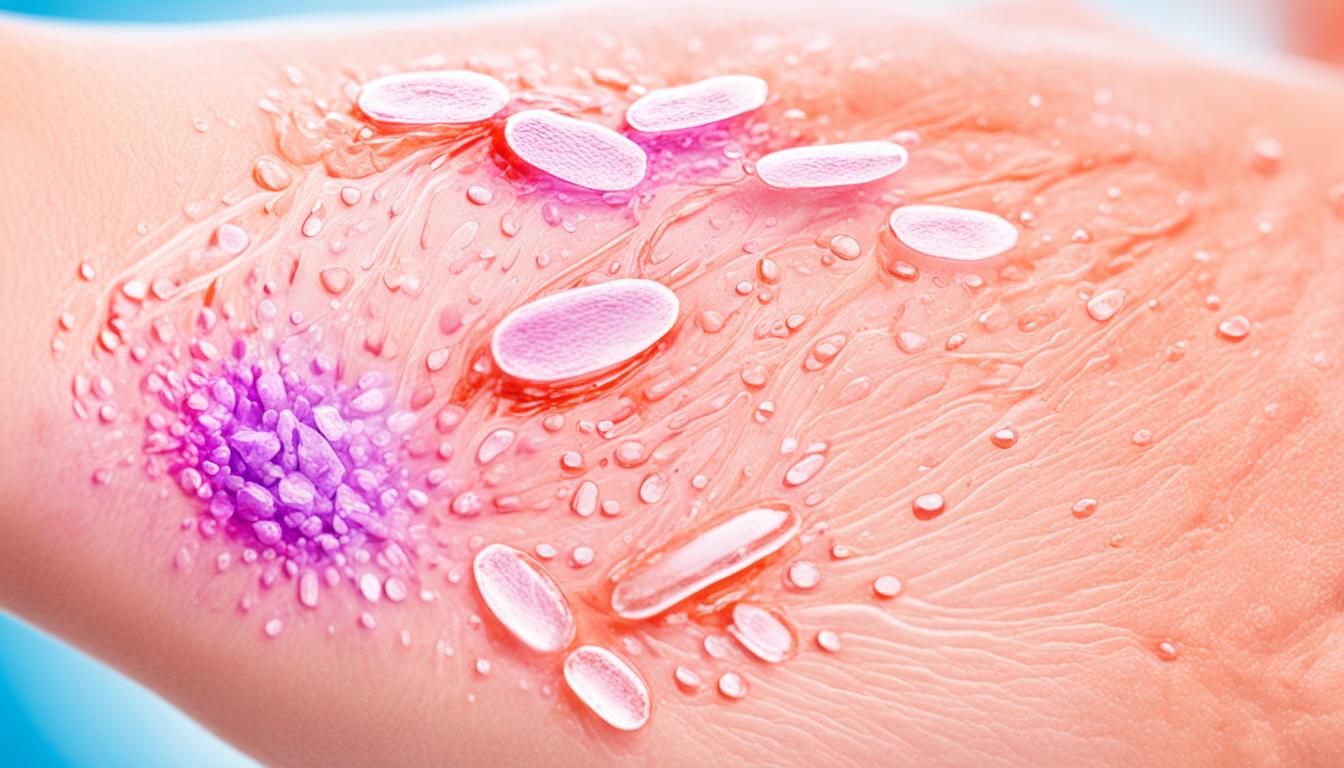Having too much sweat and smelling bad is something many people struggle with. It is different from the sweat we get when we’re hot or exercising. This issue, known as hyperhidrosis, makes people sweat a lot all the time, for no clear reason. There are two kinds of this condition. Primary hyperhidrosis makes certain parts of the body sweat excessively, while secondary hyperhidrosis causes the whole body to sweat a lot. This can happen because of health issues, medications, or changes in hormones.
The exact reasons behind primary hyperhidrosis are not completely clear. But, it is believed that genes may have something to do with it. There are various ways to manage this condition. These include using special deodorants, certain medications, a treatment called iontophoresis, and even surgery. Now, researchers in Thailand are looking into a new way to tackle this problem – stem cell therapy.
Key Takeaways:
- Hyperhidrosis involves a lot of sweating and body odor.
- Primary hyperhidrosis shows in specific areas, whereas secondary hyperhidrosis affects the entire body.
- There are ways to treat it, such as using special deodorants and certain medications.
- In Thailand, scientists are exploring stem cell therapy as a fresh approach to deal with hyperhidrosis.
- More studies are necessary to confirm the effectiveness of stem cell therapy for this condition.
Symptoms and Diagnosis of Hyperhidrosis
Hyperhidrosis is the medical term for excessive sweating. It can lead to much discomfort. It’s important to recognize the symptoms and get a correct diagnosis for treatment.
Symptoms of Hyperhidrosis
Hyperhidrosis symptoms differ based on the type. Primary hyperhidrosis targets specific body parts. These can include hands, feet, underarms, and the face. Such sweating often happens even when it’s cool and at a rest. The sweating is equal on both sides of the body.
Excessive sweating can be very embarrassing and lower quality of life. It can make social situations hard and affect relationships. People dealing with this often spend much time and energy trying to control sweat, leading to stress.
Diagnosis of Hyperhidrosis
Diagnosing hyperhidrosis requires a thorough look at someone’s history and a physical exam. The doctor will want to know about the sweating, how often it happens, and how severe it is.
During the exam, the doctor checks how and where you sweat. They look for sweat spots on your clothes and examine the affected areas. This helps rule out other health issues that might cause or worsen the sweating.
Extra tests might be done in some cases to learn more about the sweating. These could include the starch-iodine and the paper tests.
The starch-iodine test shows where excessive sweating is by making sweat that touches iodine turn purple. It helps the doctor know where to focus the treatment.
The paper test uses a special paper that measures your sweat. When pressed against your skin, it absorbs the sweat. The more it absorbs, the more severe your hyperhidrosis might be.
A correct diagnosis is key for creating the right treatment plan for hyperhidrosis. By understanding the symptoms, doctors can offer helpful ways to lessen them.
Causes and Risk Factors of Hyperhidrosis
Hyperhidrosis, or too much sweating, has many causes and risk factors. For primary hyperhidrosis, which happens without medical issues, we’re not sure of the exact cause. But, it likely comes from overactive sweat glands that the body’s own control, the sympathetic nervous system, triggers.
Primary hyperhidrosis probably has a genetic link. This means it often runs in families and affects multiple generations.
Secondary hyperhidrosis, on the other hand, is due to other health issues. Things like menopause and thyroid problems can make you sweat more. Some drugs, like antidepressants, can also cause this issue. So can changes in hormones.
If you have a family history of hyperhidrosis, you might be more likely to get it. Being overweight can also increase this risk. This is because being heavy makes your body work harder, raising your body’s temperature. Certain health issues, like diabetes, can also up your chances of having hyperhidrosis.
In summary, primary hyperhidrosis is linked to overactive sweat glands and genes. But for secondary hyperhidrosis, there are many causes, including health conditions and some drugs. If hyperhidrosis runs in your family, you’re at a higher risk. Being overweight and certain health issues can also make you more likely to have it.
Innovative Stem Cell Therapy for Hyperhidrosis Treatment in Thailand
Stem cell therapy is a new and exciting way to treat hyperhidrosis in Thailand. It involves using stem cells that can transform into sweat gland cells. These cells aim to repair the sweat glands, hopefully reducing sweating for a long time. Although we are still learning about how well this treatment works for hyperhidrosis.
Thailand is leading in medical science and stem cell research. It’s a top spot for those seeking the latest treatments for hyperhidrosis. The expertise in stem cell therapy in Thailand ensures patients get the best care.
Although stem cell therapy is promising, it requires more research and testing to ensure it’s safe and effective. Studies in Thailand are working to understand its benefits better. This research hopes to find new ways to treat hyperhidrosis effectively and improve people’s lives.
If standard treatments for hyperhidrosis have not worked for you, exploring stem cell therapy in Thailand could be an option. Make sure to talk to a doctor experienced in this therapy. They can help you understand if this treatment is right for you and what options you have in Thailand.

